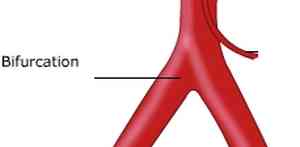

MedFriendly®


Bifurcate & Bifurcation
Bifurcate is a descriptive term for an object that is
forked or has two branches. Bifurcate can be used as a
verb when the main body of something has been split
into two branches (parts). Bifurcation means to be
forked or divided into two branches. Example of
structures in the body that are bifurcated include types
of blood vessels. One example is how the basivertebral
veins bifurcate to drain the vertebral body (bones that
surround and protect the spinal cord).
The aortic bifurcation.
FEATURED BOOK: An Illustrated Guide to the Human Body
Another example is aortic bifurcation, which is the point at which the abdominal aorta
divides into two smaller arteries (blood vessels that carry blood away from the heart).
The aorta is the largest blood vessel in the body, with the abdominal aorta being located
in the abdominal area.
Other structures in the body bifurcate besides blood vessels. A common example is the
trachea (windpipe) which divides into the right and left lung to assist in the function of
breathing. Muscle tissue fibers are known to be bifurcated at the ends. Axons of nerve
cells are also known to bifurcate. An axon is the part of a nerve that sends a message.
Bifurcate comes from the Latin word "bis" meaning "two," and the Latin word "furca"
meaning "fork." Put the words together and you have "two fork(ed)."
"Where Medical Information is Easy to Understand"™















